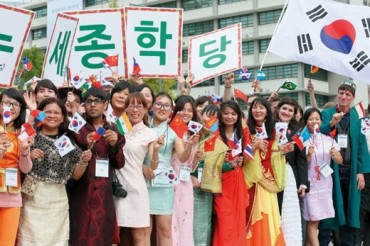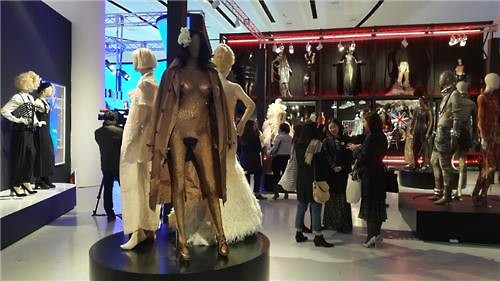
Creative works by Jean Paul Gaultier are displayed in the Seoul Exhibition at Dongdaemun Design Plaza in central Seoul on March 25, 2016. (Image : Yonhap)
SEOUL, March 28 (Korea Bizwire) – Rebellious haute couture maestro Jean Paul Gaultier struck Korean fashion lovers with awe when his variation of women’s hanbok, a traditional Korean outfit, was unveiled in the media event of his latest exhibition here on Friday.
The 64-year-old “enfant terrible” considered the upcoming exhibition at the Dongdaemun Design Plaza as a creation in its own right, a new collection and not a retrospective. The event brings together more than 150 haute couture but also ready-to-wear outfits designed between 1976 and 2016.
Gaultier has been truly fascinated with the elegance of Korean traditional female costumes, but apparently found a little something missing. Gaultier’s interpretation of hanbok came with a wittier, lighter gesture.
“Every country has got its own beauty and theme. For me, the best thing is to keep the tradition, but at the same time, keep the eye open for room for new creations,” Gaultier said in the press conference, held one day before the exhibit opens on Saturday.
Gaultier’s Seoul Exhibition, set to run until June 30, marks the 21st chapter of the cultural project of South Korean credit card issuer Hyundai Card. The exhibition is mounted by the Montreal Museum of Fine Arts in collaboration with Mason Jean Paul Gaultier, Paris.’
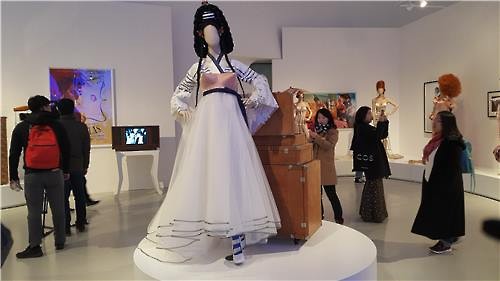
A new iteration of traditional Korean costume by Jean Paul Gaultier is displayed at Dongdaemun Design Plaza in central Seoul on March 25, 2016. (Image : Yonhap)
At first glance, Gaultier’s snow-white, oriental-style hanbok dress drapes down as gracefully as a royal wedding gown. The mannequin’s hair is delicately braided in thick strands into a majestic isosceles, coiled vertically from overhead to the neckline — a hairdo allowed for only the royal women of the Joseon Dynasty (1392-1910).
Then comes the French fisherman’s white-and-blue stripes — the world-famous “Breton fisherman stripes — printed on the jeogori, or the top piece of the female hanbok. The Breton stripes, a humor-laden trademark of Gautier’s world of design, are covered in a piece of see-through chiffon. The bottom of this Gaultier-style hanbok is cut shorter in the front to show the wearer’s ankle sticking out, covered in jolly socks with thick stripes and white round-headed stilettos.
The most stunning detail is the rebellious “cone bra,” the cream of iconic Madonna and Lady Gaga fashion. Gaultier put a pointy bra on the bosom of the gown, making the princess mannequin appear ready to snatch the king’s royal seal and run. The original teachings of Confucius may not approve of Gaultier’s fashion revolt, but many female trend-setters and celebrities these days would definitely kill to have one.
In the exhibition were mannequins made after Korean pop stars G-Dragon of boy band BigBang and CL of girl group 2NE1. Gaultier said he admired the stylish music videos of the Korean pop stars.
“I would love to go to some concerts (of Korean pop bands),” he said.’
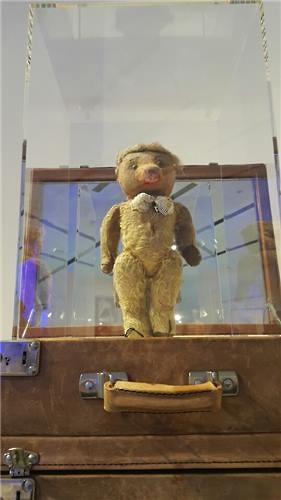
“Nana” the teddy bear by Jean Paul Gaultier is displayed in the Seoul Exhibition at Dongdaemun Design Plaza in central Seoul on March 25, 2016. (Image : Yonhap)
Since his first shows in the 1970s, Gaultier started out in the ready-to-wear business in 1976 before founding his own haute couture house in 1997. The fashion creator has been noted for his grasp of the mood of the times, claiming the right to be different. The Frenchman twists, metamorphoses, transgresses and reinterprets. Across mixed cultures and genders, he creates a new androgynous figure or delightful inversion of the codes of hyper-sexualized fashion.
His avant-garde fashion quickly addresses the concerns and stakes of a multicultural society, humorously shaking up established sociological and aesthetic codes. He offers an open-minded vision of society, a crazy, sensitive, droll, impertinent world in which people are free to be themselves, a world without discrimination, a unique “fusion couture” of light, witty blows.
“Everybody ought to be himself. People should not try to be American or French (way of fashion),” Gaultier said.’
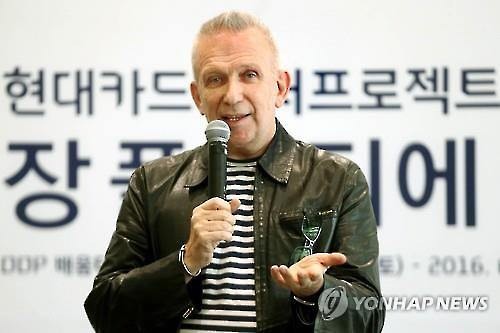
French couturier Jean Paul Gaultier speaks during a press conference at Dongdaemun Design Plaza in Seoul on March 25, 2016. (Image : Yonhap)
The “cone bra” is one of the best-known fashion items of Gaultier’s fashion world.
“Madonna was not the first one to wear my cone bras, it was my teddy bear,” the French couturier told the crowd.
In his childhood, Gaultier spent a lot of time playing with a doll, which became a source of parental disapproval. To make the worrying adults feel better, the resistant boy moved on from the doll to a teddy bear.
“That is when I changed the sex of my teddy bears with a bra,” the funnyman smiled.
Indeed, the boy knew his own way of flaunting his “masculinity.”
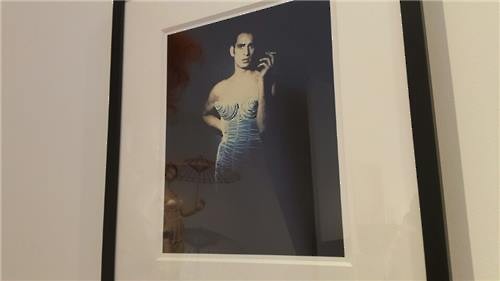
A man in a Gaultier cone breast dress appears in an undated photo displayed in the Seoul Exhibition at Dongdaemun Design Plaza in Seoul on March 25, 2016. (Image : Yonhap)
For the young Gaultier, the garments in his grandmother’s beauty salon were the earliest inspiration for his fashion. He did not have a strong inclination for school studies, but liked to scribble drawings in class — everyone wanted a copy of his work, adding more weight to the boy’s confidence in art as a possible future career.
Some of his other inspirations included the costumes of music hall dancers, photographs and motion pictures. The film “Fabalas,” produced in 1944 by Jacques Becker, led the young Gaultier to the world of haute couture.
A number of world stars have worn novel versions of his corsets with concentrically top-stitched bra cups. Madonna wore one in her legendary 1990 Blond Ambition World Tour.
Gaultier also created corsets for men, calling the fashion a common factor for the dandies and military men of 19th century England.’

A painting of Jean Paul Gaultier’s work is displayed in the Seoul Exhibition at Dongdaemun Design Plaza in Seoul on March 25, 2016. (Image : Yonhap)
Gaultier was born in France but he has always admired the city of London and considers it as his second home.
The dividing contrast between “French elegance” and “London avant-garde” is the fountain of inspiration for his unique blend of tradition and funky enthrallment.
The tattooed punks of Trafalgar Square in London have apparently inspired young Gaultier, later translating into the combination of latex, leather, lace, tartan, safety pins, studs and metal spikes that appear on his London couture.
In the exhibition, numerous objects and archival documents are also shown to the public for the first time. Sketches, stage costumes, footage from films, fashion shows and concerts, video clips and dance performances. Even television shows, including the animated cartoon series “The Simpsons,” illustrate Gaultier’s most emblematic artistic partnerships with filmmakers such as Pedro Almodovar, Peter Greenaway, Luc Besson, Marc Caro and Jean-Pierre Jeunet. Some other prominent partners include dancers like Angelin Preljocaj, Regine Chopinot and Maurice Bejart; French singers including Yvette Horner and Mylene Farmer; and international pop stars such as Madonna and Kylie Minogue.’
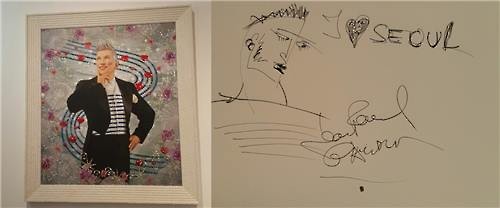
A painting of Jean Paul Gaultier and his autograph are displayed in the Seoul Exhibition at Dongdaemun Design Plaza in Seoul on March 25, 2016. (Image : Yonhap)
Gaultier will leave for France on Saturday after the official launch of the 12th and last instance of the five-year-long world tour exhibition.
The previous 11 world exhibitions, hosted in global cultural meccas including Dallas, San Francisco, Madrid, Rotterdam, Stockholm, New York, London, Melbourne, Paris and Munich, have already captivated nearly two million visitors.
About choosing Seoul as the finale of his exhibition tour, Gaultier said, “After traveling the world five years with this exhibition, I thought it would be great to have the finale in Seoul, the only venue in Asia, in the fantastic DDP Museum of Zaha Hadid. I could not have dreamed of a more beautiful place to present my creations to Asia.”
(Yonhap)






